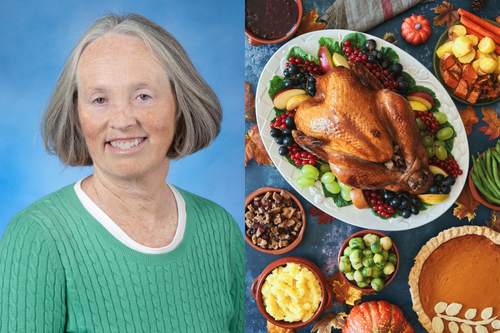
The typical American consumes over 4,500 calories on Thanksgiving Day between snacking and dinner alone, according to the Calorie Control Council.
Joanne Slavin, Ph.D., a professor in the Department of Food Science and Nutrition in the University of Minnesota’s College of Food, Agricultural and Natural Resource Sciences (CFANS), answers questions about how to enjoy holiday eating while also making wise food choices for good, overall health.
Q: What advice do you have for holiday eating?
Dr. Slavin: If you start the bad behavior at Thanksgiving and then run it through December, the amount of weight you can gain is impressive or more likely depressing. Skip a few of the side dishes or keep the pie and ice cream for a later eating episode. At the same time, remember the importance of rituals and family customs in holiday eating, and don’t diss Aunt Eleanor’s jello salad, the white buns that make an appearance at holiday meals, or the sweet potato hot dish with marshmallows. Sure, these items don’t meet many of our new nutrition norms: whole grains, low in added sugar, mostly whole food ingredients – but small helpings of most items can be enjoyed with family and friends. We know that food keeps us healthy, but it is much more than the nutrients that come from food. Support your local farmers, enjoy your food, gather with friends and family and try new recipes or exchange holiday cookies. If you are lucky enough to have excess food at your house, donate to a food shelf.
Q: Are there particular considerations for people who are following heart-healthy diets (e.g. pre-diabetic or are managing other conditions)?
Dr. Slavin: Our usual dietary guidelines, moderation and variety, continue to be our guiding principle. Of course, our usual holiday favorites tend to be high in fat and sugar, but we can balance higher calorie choices with vegetables, whole grains, fruits and legumes. Food safety continues to be a concern, so make sure you don’t leave the stuffed turkey sitting out as you watch the football game. Even more important, don’t stuff the turkey at all. Consider cooking the stuffing separately, and fill it with healthy ingredients like fruit, nuts and vegetables. Challenging food issues, such as allergies, vegetarian diets, strict limits on sodium, saturated fats or added sugar should be discussed before the gathering so everyone can partake in a celebratory meal.
Q: What’s different in 2021 for holiday eating?
Dr. Slavin: COVID is still around and will require respect of different rules for masking, social distancing and consideration for family members at high risk. Consider this our new normal and remember how much fun it is to eat outside and play flag football. This holiday will also be the year of supply chain disruptions, so your favorite food may be expensive or not available at all. This is new territory for most Americans and you may enjoy combining plant foods, such as grains and legumes, to replace some of the usual protein in the meal.
Q: What is special about holiday eating in Minnesota?
Dr. Slavin: Walleye, wild rice, and wild game are all special Minnesota treats that can be enjoyed during the holidays. Load up on vegetables to make sure you get the vitamins you need. Pumpkins, apples, nuts and cranberries make eating festive. Holiday drinks, especially hot versions, are a fun tradition during our cold winter months.
Q: What does your work in food science and nutrition show?
Dr. Slavin: We know that dietary fiber is an under-consumed nutrient in the U.S., and the best way to alter the microbiota in a healthy direction is a higher intake of dietary fiber. We also work with fermented foods and live microbes — such as yogurt, sauerkraut and tempeh — in identifying their health benefits. Plant foods are widely promoted, and carbohydrate staple foods, such as potatoes, rice, pasta, tortillas, and bread, can form the basis of our diets and provide important plant protein. To get the nutrients you need daily, make sure you get the recommended servings from myplate.gov, otherwise, you will be low on shortfall nutrients, including dietary fiber, potassium, calcium and Vitamin D. You can get Vitamin D in our wonderful Minnesota sunshine. Be sure to bundle up and take part in activities that get you moving safely during the winter months so you can enjoy those holiday cookies.
Joanne Slavin, Ph.D., RDN is a professor in the Department of Food Science and Nutrition in the University of Minnesota’s College of Food, Agricultural and Natural Resource Sciences (CFANS). She is the managing partner of the Slavin Sisters Farm LLC in Walworth, WI, and a member of the Sustainable Nutrition Scientific Board which presented their work at the IUCN World Conservation Congress in September 2021. She is also a member of Protein in a Changing Environment (PRICE), a multi-stakeholder, interdisciplinary scientific effort examining the intersection of protein nutrition, food systems, and health.
###
About “Talking...with U of M”
“Talking...with U of M” is a resource whereby University of Minnesota faculty answer questions on current and other topics of general interest. Feel free to republish this content. If you would like to schedule an interview with the faculty member or have topics you’d like the University of Minnesota to explore for future “Talking...with U of M,” please contact University Public Relations at [email protected].
- Categories:
- Health




